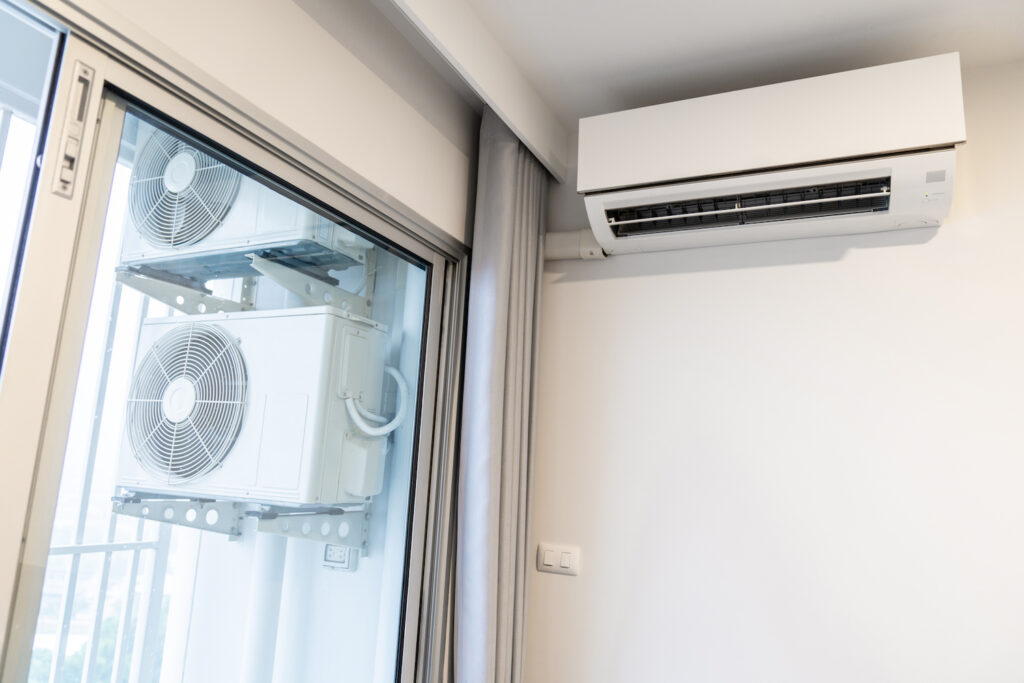Split system air conditioning is an HVAC (Heating, Ventilation, and Air Conditioning) system commonly used in homes and small commercial buildings. Unlike a traditional central air conditioner, a split system has two main components – indoor and outdoor units – that work together to cool a space.
What is a split system?
A split air conditioning system consists of an indoor unit, which is typically mounted on a wall or ceiling, and an outdoor unit, which is placed outside the building. The indoor and outdoor units are connected by refrigerant lines, allowing the system to transfer heat between the two components.
Wall Mounted vs Ducted Air Conditioning Units
Split systems can come in two main configurations: wall-mounted units and ducted units:
Wall-mounted units are the most common type of split system, with the indoor unit mounted on the wall and the outdoor unit placed outside. These are often the easiest and most cost-effective options for retrofitting air conditioning into an existing space.
Ducted split systems are units installed in the ceiling or attic, with ductwork running to vents in each room. This is popular in commercial units and can provide a more discreet and integrated look, but it may be more complex and expensive to install.
How does a split air conditioning system work?
The basic principle behind a split air conditioner is the transfer of heat. The outdoor unit contains the compressor and condenser, which work together to remove heat from the refrigerant. The indoor unit has an evaporator, which absorbs heat from the internal air and cools it down before circulating it back into the room:
- The outdoor unit compresses the refrigerant, causing it to become hot and high-pressure.
- The hot refrigerant flows to the outside condenser, releasing heat to the outside air.
- The refrigerant then flows to the inside unit’s evaporator, which absorbs heat from the internal air, causing the air to cool down.
- The inside unit’s fan circulates the cold air back into the room.
- In a low-pressure, low-temperature state, the refrigerant returns to the outside unit’s compressor to repeat the cycle.
Do split systems heat and cool?
Yes, many split systems are designed to be both heating and cooling systems. These are known as “heat pump” systems, as they can reverse the refrigeration cycle to provide heating and cooling. In heating mode, the units’ roles are reversed, with the outdoor unit absorbing heat from the outside air and the indoor unit releasing that heat into the indoor space.
Split AC Benefits and Considerations
Split systems are popular air conditioning units because they offer several advantages over other types of HVAC systems:
- Energy efficiency: Split systems are generally more energy efficient than traditional central air conditioning systems, as they only cool the areas that are in use.
- Flexible installation: The two units can be installed in different locations, making fitting the system into your home or building easier.
- Quiet operation: The outdoor unit, which contains the noisier components, is located outside, resulting in a more peaceful indoor environment.
However, there are also some considerations to keep in mind when choosing a split system:
- Cost: Split systems can be more expensive to install than other HVAC options.
- Refrigerant lines: The coolant lines that connect the indoor and outdoor units must be properly installed and maintained to prevent leaks.
Maintaining Your Split System
Proper maintenance is essential to make sure your split system air conditioner continues to operate efficiently and effectively.
One of the most important maintenance tasks is regularly cleaning or replacing the air filters in the indoor unit. Over time, these filters can become clogged with dust, dirt, and other airborne particles, restricting airflow and reducing the system’s performance. Depending on usage, the filters should be cleaned monthly or replaced every few months to maintain optimal airflow.
In addition to the filters, it’s essential to check and clean both units periodically. The inside unit’s evaporator coil should be inspected for any buildup of dirt or debris, which can obstruct heat transfer and lead to reduced cooling capacity. The outside unit’s condenser coil and fan should be checked and cleaned for proper airflow and heat dissipation.
While you can handle some basic maintenance tasks of home and office air conditioning units, scheduling professional servicing and inspections every 2-3 years is recommended. A qualified HVAC technician can inspect, identify potential issues, and ensure the system is operating at peak efficiency. They can also provide guidance on troubleshooting common problems, such as refrigerant leaks or electrical malfunctions.
Choose the Right Air Conditioning System with GLP
When choosing the right split system air conditioning for your home or business, the experts at GLP HVAC Services can help. We’ll assess your cooling and heating needs, the layout of your space, and your budget to recommend the best-split system solution. Contact us today to learn more and get a free quote.
